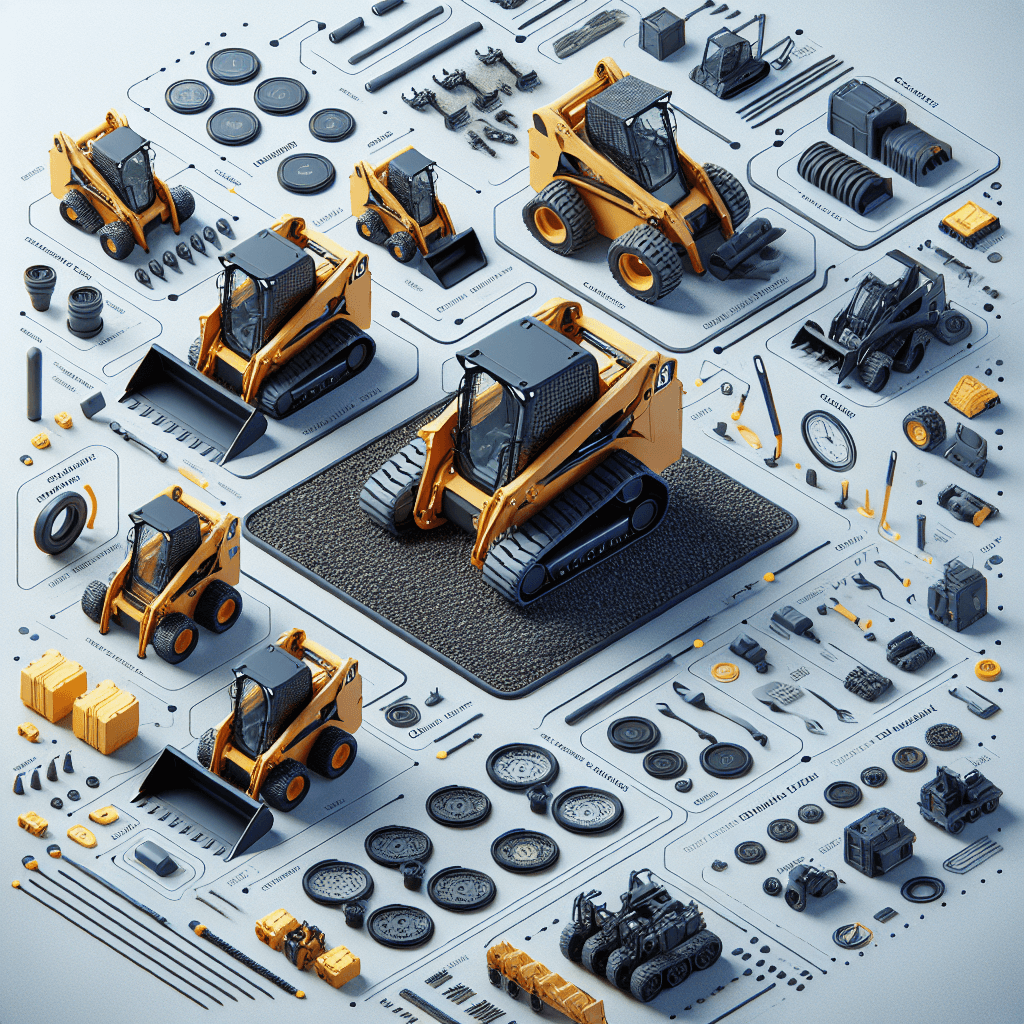Introduction
In the ever-changing fields of landscaping and building, dependability and quality rule most importantly. Working with a reliable heavy machinery specialist guarantees safety and excellent performance, so enabling your initiatives to produce outstanding results. All the difference might come from the correct tools. In these sectors, two of the most adaptable and often used machinery are skid steers and Compact Track Loaders. Though each has advantages and ideal use cases, choosing which one best fits your circumstances could seem difficult.
This manual seeks to clarify the variations between Compact Track Loaders and skid steers so that you may have the knowledge required to choose wisely. Knowing the subtleties of these machines can help you maximize your operations and get better outcomes on the job site regardless of your level of expertise in construction, landscaping, or equipment enthusiast.
Key Differences Between Compact Track Loaders and Skid Steers
Mobility and Terrain
Compact track loaders are designed with tracks instead of wheels, making them particularly well-suited for soft, uneven, and muddy terrains. The tracks help the machine float over places where wheeled equipment could find difficulty by more equally distributing its weight. For works in damp surroundings, such marshy settings or building sites with loose soil, CTLs are therefore a great option.
Conversely, skid steers have wheels, which provides better performance on level, hard surfaces such as asphalt and concrete. For jobs requiring great agility, their wheeled form offers agile handling and fast direction changes. In urban building projects where space is constrained and accuracy is critical, skid steers shine.
Weight Distribution
CTLs’ reduced ground pressure is one of its best traits. CTLs minimize ground pressure since its tracks distribute the weight of the machine across a greater area, therefore lowering the danger of damage to delicate surfaces. Working on lawns, gardens, or other delicate environments calls for this quality especially.
Conversely, because of their wheeled arrangement, skid steers have more ground pressure. More compact weight distribution as a result improves their capacity to run in confined areas. Skid steers are a favorite among builders who must complete jobs like demolition or trash disposal in limited spaces as their small size makes them easy to handle.
Cost Considerations

When weighing financial issues, one should take into account the initial purchase price as well as the continuous maintenance costs. Generally speaking, CTLs cost more initially than skid steers. Their track system’s complexity and the related technologies help to explain their pricing discrepancy.
Still, usage and application will affect maintenance and running costs. Because of the wear and tear on its tracks, especially if operated mostly on abrasive surfaces, CTLs could need more frequent maintenance. Although their simpler wheeled arrangement results in less maintenance, skid steers can be more expensive if utilized on uneven ground.
Applications and Use Cases
When to Choose a Compact Track Loader
In uses where ground conditions are less than perfect, compact track loaders excel. For chores including grading, trenching, and soft ground preparation for planting, they are ideal for landscaping. For operations involving excavation and earthmoving, where their stability on uneven ground guarantees safety and efficiency, CTLs are also a first choice.
CTLs provide unparalleled adaptability for those in the building industry working in places likely to rain or with often shifting weather. Their ability to negotiate muddy terrain without becoming bogged down makes them quite valuable in demanding surroundings.
When to Choose a Skid Steer
In uses where ground conditions are less than perfect, compact track loaders excel. For chores including grading, trenching, and soft ground preparation for planting, they are ideal for landscaping. For operations involving excavation and earthmoving, where their stability on uneven ground guarantees safety and efficiency, CTLs are also a first choice.
CTLs provide unparalleled adaptability for those in the building industry working in places likely to rain or with often shifting weather. Their ability to negotiate muddy terrain without becoming bogged down makes them quite valuable in demanding surroundings.
Performance and Power
Engine Power and Hydraulic Performance
Comparing skid steers with compact track loaders, hydraulic performance and engine power are major determinants of total capability. Usually with more strong engines meant to manage greater loads and more difficult operations, compact track loaders Applications like large-scale excavation operations benefit from this extra capability since strength is required to effectively move significant volumes of material. Many times fitted with sophisticated hydraulic systems with strong lifting capacity, CTLs improve their performance in demanding surroundings even more.
Conversely, although usually having somewhat less engine power than CTLs, skid steers are well-known for their fast response times and smooth running. Skid steers’ hydraulic systems are designed for adaptability, allowing rapid attachments changes and the capacity to handle a broad spectrum of activities from lifting to excavating. Their agility required for fast-paced activities needing accuracy and reactivity comes from their power-to—-weight ratio, which makes them a great choice for smaller-scale projects and urban building.
Operator Comfort and Visibility
Operator comfort and visibility are also another crucial factor to weigh while deciding between skid steers and small track loaders. Often featuring large cabs with ergonomic controls meant to reduce operator tiredness during prolonged operation, CTLs also have Usually, the shape of the tracks improves the vision from a CTL cab, therefore giving operators a wider perspective of their surroundings—especially helpful in challenging work settings.
Though small, skid steers also stress operator comfort by including simple controls and visibility choices necessary for high-performance operations. Many skid steer models have choices for covered cabs with climate control, therefore improving the whole working environment. These machines’ clear sightlines to front attachments help operators to negotiate limited areas while keeping control.
Pros and Cons
Pros and Cons of Compact Track Loaders
Pros
- Ideal for soft and uneven terrains
- Lower ground pressure protects sensitive surfaces
- Excellent stability and traction
Cons
- Higher initial purchase cost
- Increased maintenance for tracks
- Less efficient on hard surfaces
Pros and Cons of Skid Steers
Pros
- Superior maneuverability and agility
- Lower upfront cost compared to CTLs
- Versatile for various construction tasks
Cons
- Higher ground pressure can damage soft surfaces
- Limited performance on wet or muddy terrain
- Requires caution on uneven ground
Conclusion
Ultimately, your particular goals and project requirements will determine which of compact track loaders or skid steers best fit you. For soft and difficult terrain, CTLs provide unmatched performance; so, they are a great help for landscaping and earthmoving activities. Conversely, skid steers give the agility and adaptability required for urban building and demolition projects.
By weighing the pros and cons outlined in this guide, you can make an informed choice that aligns with your operational goals. For those considering adding a new piece of equipment to their fleet, exploring options at Typhon Machinery or checking the biggest compact track loader models available can further enhance your decision-making process.
Recall that proper tools can increase your output and efficiency, thereby keeping you ahead in the cutthroat fields of gardening and building. As you choose whether a small track loader or skid steer is the ideal fit for your company needs, give your terrain, project scope, and budget great thought.
